iPhone 13 Pro & iPhone 13 Pro Max, Review: Everything Changed… On A Swipe
The most complete review I've written in my life.
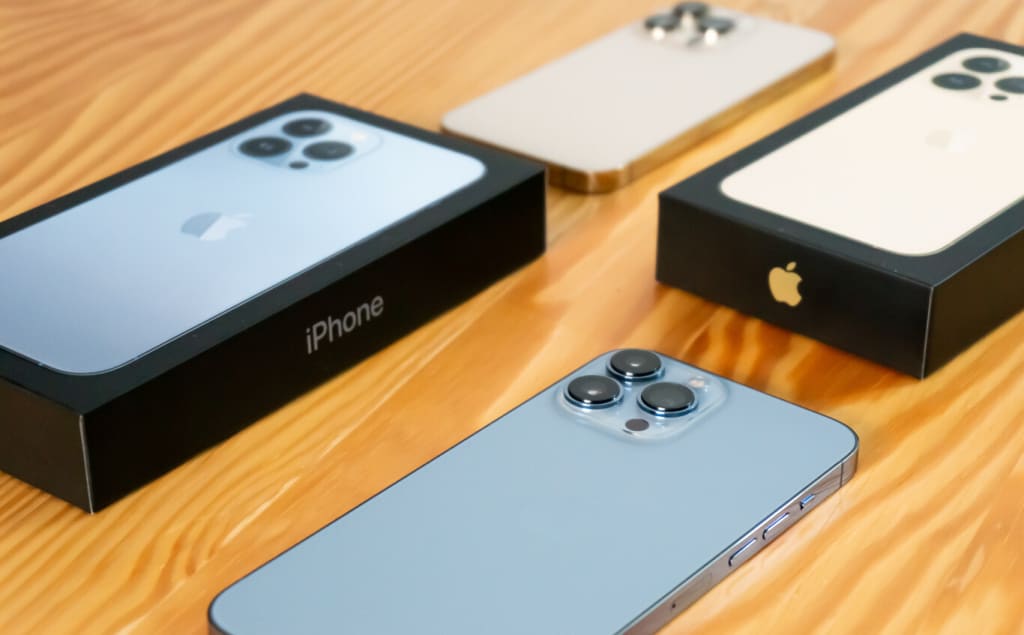
Finally, they are here! The iPhone 13 Pro and the iPhone 13 Pro Max. The launch of the four versions of the iPhone 12 made Apple’s intentions clear: to concentrate the changes and improvements of the generation in each container but providing certain decision points to the user to choose one model or another — practically one size or another. This helps to further align our device with our day-to-day if we do not need the improvements in the cameras, or we prefer more battery.
The iPhone 13 models were a surprise in the keynote because they went unnoticed. Apple clearly explained all its features at the Apple Event but everyday use and capabilities in our day to day are what we again understand that the company wanted to answer the question “What makes an iPhone, an iPhone?”, Becoming in the first days since it is on sale in the real surprise of the event. Not for less: it is more iPhone than ever.
Apple has a tremendous production to film the keynote and they are specialists in providing it with a marvelous atmosphere when it comes to presenting the company’s most profitable product. But is it correct to judge the iPhone based on the way it was presented to the world? It is a bit the sensations that I have as I write these lines.
It is normal, the first week after the launch of a new iPhone — ironically before it is released to the public — there are all kinds of opinions about whether the new iPhone is good or bad if it innovates or not if it is worth updating or not. And that’s why I’m here, to tell you absolutely everything about this new device based on the massive tests that I have done, and believe me I have squeezed every last drop out of it.
I must confess that making these reviews always pose a huge challenge when it comes to disconnecting from the popular noise. In fact, it is something that happens every year. So that you understand me better, this is like going to a trial and that the popular jury should not contaminate its final verdict with opinions and outside news.
So … What makes an iPhone, an iPhone?
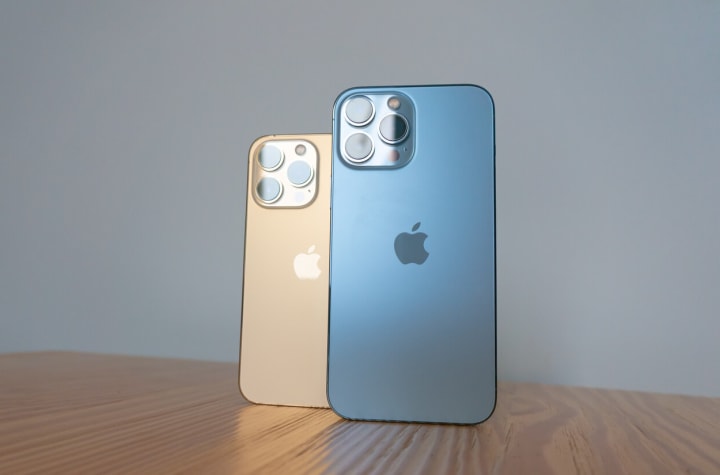
Curiously, what can best define this new iPhone is precisely what made it go unnoticed: at first glance, the design looks identical to the previous generation … but the details are what make the difference. On the outside, we have the same square, a straight-edged design that defined the iPhone 12: the stainless steel frame worked very well in the previous generation — I carry the iPhone without a case (although always carefully) and have not had a mark in the last year. The surface of this frame that surrounds the structure of the phone is mirror-like and slightly lowers the tone of the color that we have chosen for the iPhone.
The iPhone 13 Pro, as its name implies, is aimed at more professional or advanced users with tools and functions that allow you to do more things than the iPhone 13. Therefore, you will notice a slight difference in the approach that I give to both reviews. This review goes that way, especially as a content creator. As a person who uses his smartphone as a work tool, not only for administrative tasks but also to create content in photos, editing, and staying connected with various aspects of my life. The iPhone 13 review is a bit more “relaxed” focused on daily use, without so much technical detail, more adapted as an extension of our lives.
I’ll be very honest: The iPhone 13 Pro isn’t for everyone.
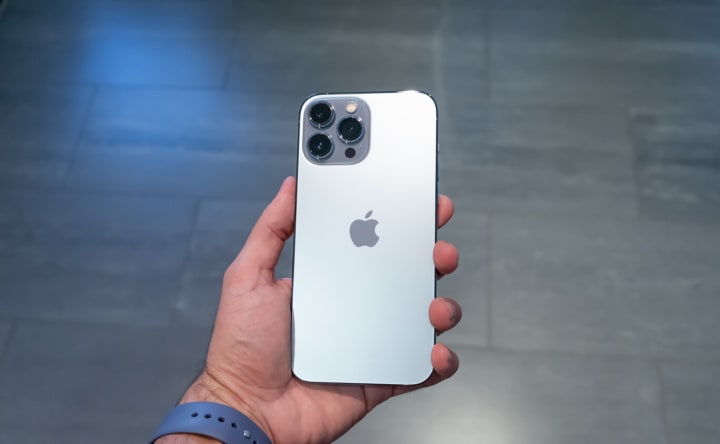
If you do not consider yourself an advanced user, the iPhone 13 is an extremely competent device and — in many ways — above anything else that you find in the competition.
In this generation, Apple has chosen pastel tones with alpine blue as the flagship color of the iPhone 13 Pro (one of the models we are testing). Undoubtedly, one of the most beautiful of recent years — with the permission of the “night green” of the iPhone 11 Pro — which in person looks spectacular: as always, it is the incidence of light against the body of the device that will set the tone. Sometimes it will seem more silver, in others, a more marked blue without attracting attention due to its sobriety. For the rest of the colors, we find graphite, silver, and a gold version practically identical to the one we met with the iPhone 12 Pro.
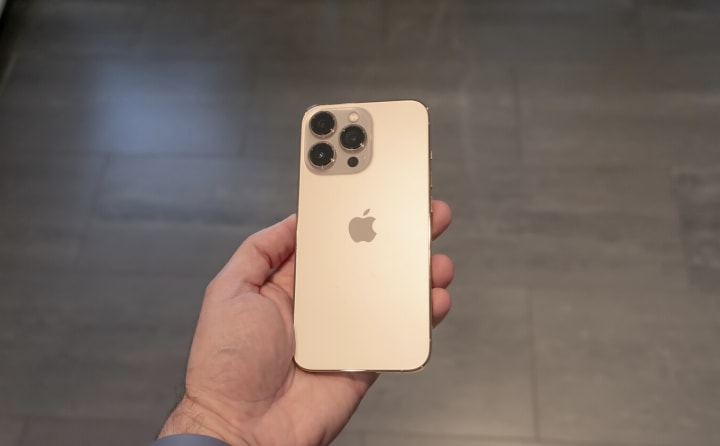
The front part still has the Ceramic Shield finish to make the front glass very resistant, especially to falls. For this, Apple tells us that nanoceramic crystals have been applied in the composition of the glass, whose objective is to increase the resistance of the structure. The back still has a slightly rough feel except for the company logo, which has a more reflective finish.
About the weight, on paper, the technical characteristics tell us that it is slightly more than 15 grams heavier than the previous generation, although even weighing both phones in two hands it is difficult to notice any difference. If you are used to a Pro Max, in this respect the iPhone will not seem more uncomfortable or heavier — and the appearance as we have seen continues with the previous design.
A small difference in this area is the speaker in the form of a horizontal slit, which now seems to come out of the frame of the TrueDepth cameras and stick to the top edge of the phone, practically being part of the non-screen edges of the iPhone.
In the iPhone 13, it is a few millimeters larger, but it behaves in power and volume of sound practices with the iPhone 12. The interesting thing about this new location is that it seems that they already have this change prepared for future projects with a “notch” much reduced — or completely eliminated.
The same MagSafe capabilities are maintained, being compatible with all the accessories that already exist, and working in the same way. Accompanying the launch of the iPhone 13, Apple has updated the MagSafe leather wallet to which it has included an NFC chip. Thanks to this, if the wallet is detached from the phone, the iPhone is able to detect it and warn the user with a certain vibration, in addition to locating the exact place within the Search application. This accessory (like all those that right now carry the MagSafe logo) is interchangeably compatible with the iPhone 12 and iPhone 13, in any of their versions.
Super Retina XDR with ProMotion
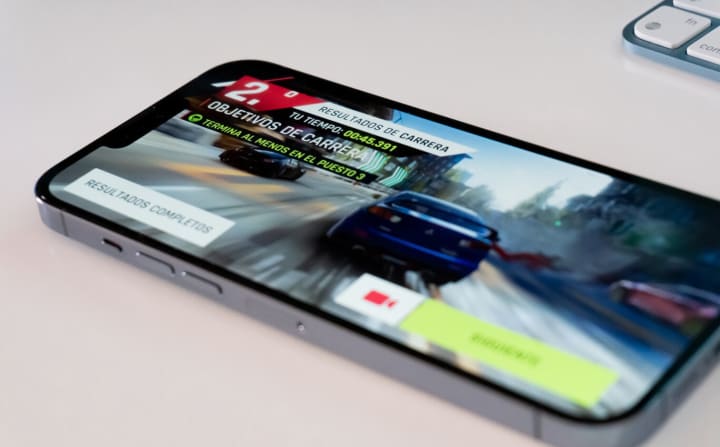
It only takes the first scroll, during the configuration phase of the iPhone 13 Pro to discover that the refresh rate of the screen of up to 120 Hz makes a very noticeable difference in the way of interacting with the graphical interface.
Yeah, yeah … I know “Apple is late to the game”. That Android devices have had that 120 Hz on the screen for a few years, but it’s not that simple. The way the iPhone 13 Pro does it is a bit different.
Believe me, I’ll explain it.
Look, this is like this: Along with the new operating system (iOS 15), the device adapts the refresh rate based on what is happening on the screen. That is, if you are reading a text, the screen is updated fewer times per second, but if you are playing a video game, browsing a long list, quickly scrolling through the timeline of your favorite social network or on a web page, The screen is updated up to 120 times per second.
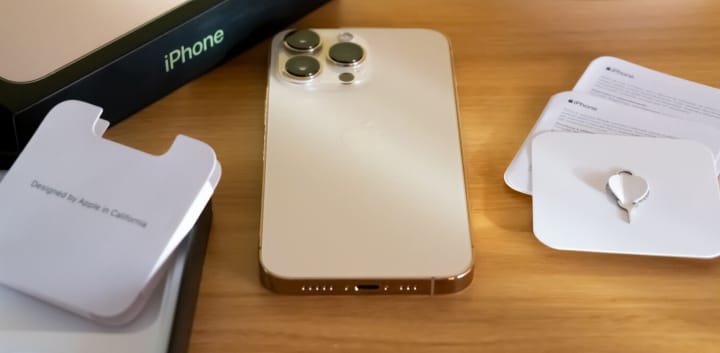
The effect achieved is that the movements of the elements on the screen look and feel much more real, as they go exactly at the same speed as the movement of your finger. But being adaptive is more natural and, above all, (very important) it saves energy when it is not necessary to update the screen so many times per second.
That screen refresh adaptability is where Apple has differentiated itself with the iPhone 13 Pro. That Android devices have 120 Hz screens, yes, it is true, but no manufacturer (except Google with the Pixels, perhaps) has such a control granular and accurate about screen refresh rate.
Another important difference between the iPhone 13 Pro and Android devices in this regard is that developers can choose the screen refresh rate for their applications. In this way, a video game can indicate that it will always need 60 frames per second, except when the player is doing some configuration or when the game is paused, for example.
But … do ProMotion displays really change the experience as it did with Retina displays? In a way, yes.
We could live perfectly with screens without both technologies, but once we started using graphical interfaces where it was impossible to differentiate the pixels, it was difficult to go back. With the 120 Hz refresh rate the same thing happened to me. I do not want to go back.
Fun fact: The screen also has other improvements, including an extra 25% brightness outdoors (1000 nits), and when viewing HDR content — both photos and videos — it increases the brightness to 1200 nits.
In addition, the Super Retina XDR screen on these new iPhone 13 Pro and iPhone 13 Pro Max improve the brightness outdoors up to 1000 nits, maintaining the 1200 peak nits when we play HDR content (both videos and photos).
Reviewing the heating level of the iPhone 13 after use with performance tests, we observe that it reaches 37.3º — always with tests that involve having the screen turned on at 100%, and after running complex benchmarks. A fairly normal value after intensive use and that does not bother the hand since they are specific peaks.
If we force the processor a little more, leaving a demonstration of a game like Asphalt 9 for several hours, we see that higher values of heat are reached (a maximum of 43.2º in my tests), which were reached right at the time of the measurement and that it makes the heat noticeable in the hand but that, of course, it can be used without problems.
The iPhone 13 Pro Camera is From Another Galaxy
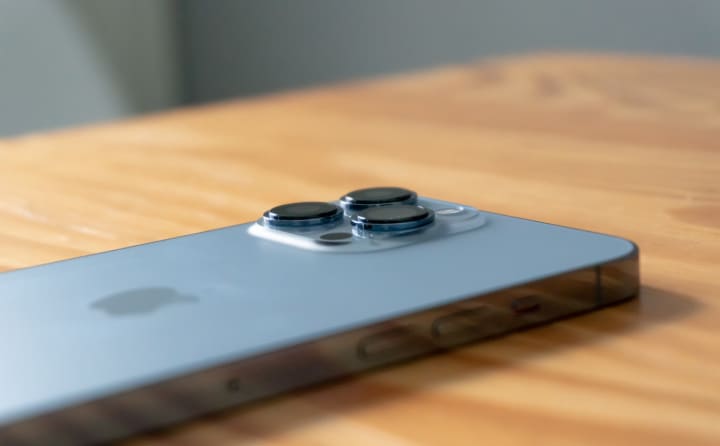
The holy grail of the iPhone 13 Pro is its new camera system that improves on previous models, yes, I know it is something that is said year after year, but this time it really is impressive. I would like to make something very clear before continuing: this is the best camera, photo or video, available on a smartphone. Period.
Yes, there are specific points where a competitor has more variety than the iPhone. That another device offers a mode for astrophotography, that another device has computational photography and in a particular case achieves a better result, that night mode was better at some point when the iPhone X or iPhone XS were sold.
But, in general, in day-to-day life, in both normal and professional uses, there is no mobile device that comes close to the iPhone. In fact, it is very difficult for me to trust another smartphone when using it for work. And it should be so. After all, we pay a lot of money for this device, so it must offer the best of the best.
Apple has updated the three cameras of the iPhone 13 Pro and has made important improvements, let’s talk about each of them:
Ultra Wide Angle — Aperture improvement, now ƒ / 1.8 with a new sensor, improved autofocus and 92% brighter.
Wide-Angle — They also improve the aperture, now ƒ / 1.5, with the largest sensor that Apple has put on an iPhone. 49% brighter compared to iPhone 12 Pro Max and 2.2 times brighter compared to iPhone 12.
Telephoto — Focal length improvements, now 77 millimeters with 3x optical zoom.
The iPhone 13 Pro comes with improved night mode and Smart HDR 4, which also perfects its predecessors. The combination of updated hardware and advancements in computational photography make what I’ve always considered the best mobile camera even better. Not forgetting the presence of the LIDAR sensor, which helps to focus in low light conditions. To all this, we must add some other things that they have incorporated.
Introducing ProRes
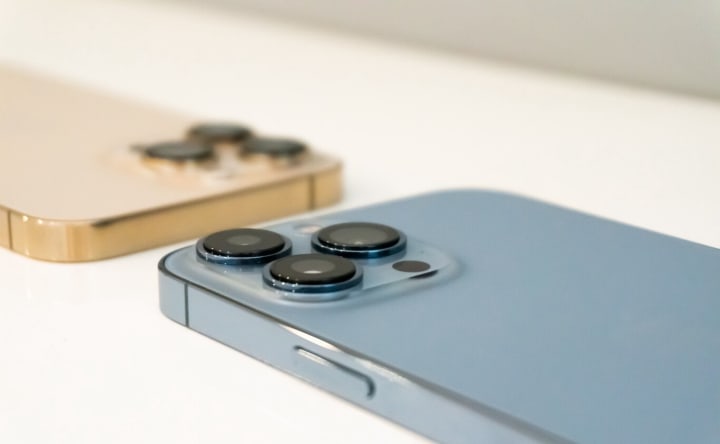
ProRes is a codec developed by Apple for video editing and production. It is capable of offering a high bit rate, supports up to 8K, and preserves a higher quality and quantity of information than a format intended for content consumption, such as H.264 or H.265.
The iPhone 13 Pro and 13 Pro Max are capable of recording video in ProRes. It is not the same, but its equivalent would be like taking photos in RAW instead of JPG.
Because the ProRes format compresses video frames independently, without connection to the previous or next frame it is much easier to decode it, and therefore better performance when editing video is obtained, in addition to obtaining the higher quality.
Note: Although it requires much less storage space than uncompressed video, the ProRes format can fill up the iPhone’s memory quite quickly. That’s why the version with 128 GB of storage does not support 4K recording with this codec.
Photographic Styles
Photo Styles let you customize the overall style of the photos you take without applying filters to the entire image. Instead, it lets you apply more contrast, brighter, or warmer, without especially ruining the subject’s skin tones.
These types of customizations are common in photo retouching applications — such as Lightroom — when working with RAW photos. With this feature, Apple gives you the option to choose between different styles from the moment you take the photo.
Macro Photos
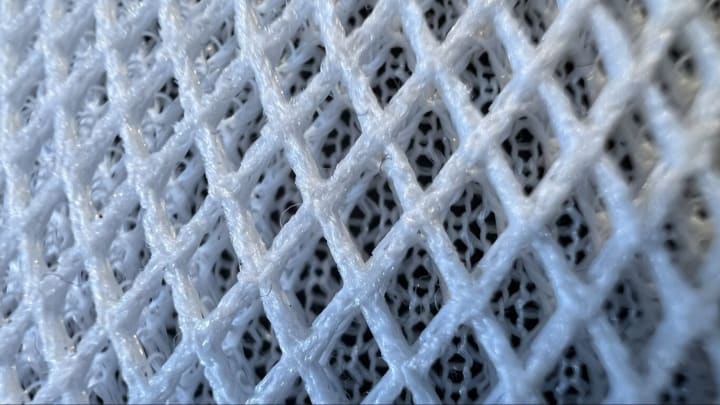
Now when you are using the ultra-wide-angle camera and you bring it close to an object 2 centimeters, the macro mode is automatically activated. It allows you to take greatly detailed images of objects, which with a little creativity also helps to take very interesting photos.
Macro mode not only works for photos, but it also works for video and can be combined with slow-motion modes and timelapse mode. Although the macro mode is currently activated automatically, through a system update that will arrive in the fall, it can be disabled manually, if necessary.
Cinematic mode
Do you remember that at the beginning of the review I told you that Apple was tremendously spectacular in the production of the Keynotes? And, of all the announcements made during the presentation of the iPhone 13 and iPhone 13 Pro, the cinematographic mode was the one that most caught my attention, I would dare to say that not only to me. From a video content creation point of view, the ability to separate the subject from the background is key. This is known as depth of field. With the photos, we can already do it from the iPhone X with the portrait mode.
But on video, depending on the situation and the separation, everything looks flat. It does not matter if it is 4K or not, being a lens and a small sensor, the distance between the subject and the background has to be very wide to achieve a real separation.
To achieve this under normal conditions, you need a camera with a large sensor and a lens that allows large apertures.
Depth of field gives the viewer a more organic perception of distance, creating a more natural feeling in the video. From a creative point of view, I can also increase or decrease the separation by blurring the background more or less.
Ok, so far nothing of the above could be done on an iPhone. The targets are very small and so are the sensors. Apple has solved it with the new cinematic mode, applying computational algorithms that analyze each of the video frames in real-time to focus on different points of the plane, creating that feeling of depth.
It is the portrait mode, but applied to video and with the possibility of rack focus, to change the attention from one subject to another. It’s a basic creative technique because it allows you to use the video itself to subtly tell your audience where they should be focusing.
I find it absolutely amazing and outstanding what Apple has achieved with cinematic mode. It is a huge technical achievement that requires an immense amount of calculations since the resulting video is also in Dolby Vision. Doing so many calculations per second, in real-time, keeping dozens of variables that change at all times, and getting that result on video is very impressive.
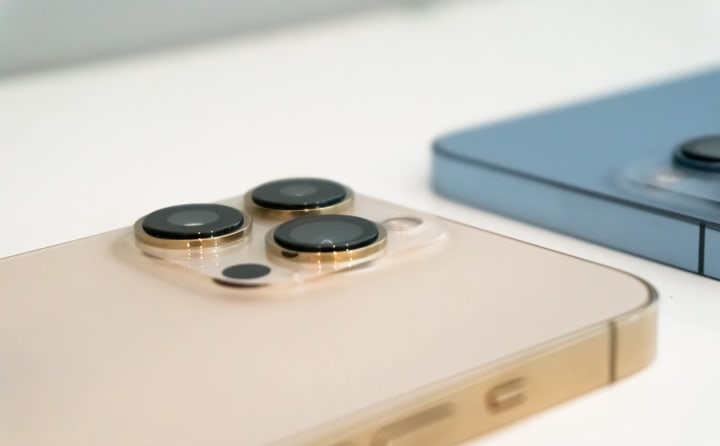
But yes, there is a but. One but. And it hurts me to say it but something that makes me feel like the cinematic mode is halfway there is that it doesn’t record at 60 frames per second and/or 4K. It is limited, and cannot be switched to 1080p and 30 frames per second.
But … Why is it so important to record at 60 frames per second? Because that way I can record resource shots and lower it to 30 frames per second and create a slow-motion effect (which comes in handy for making resource shots). The iPhone is the perfect tool for recording resource plans since it is a small device and you always carry it in your pocket. Since it has the optical stabilizer even more!
I can imagine dozens of situations where cinematic mode at even 1080p and 30 frames per second is much more than sufficient. But I can’t help but think that Apple is stuck halfway with cinematic mode. I understand that the technical challenge of achieving this is immense. I guess we will see a considerable improvement next year with the iPhone 14 Pro with an A16 Bionic chip.
I have tested the cinematic mode in different situations and with different objects. The detection is not limited to faces, it also does it with objects and, for the first version, it works well. In complex situations, it can fail, but I understand that I am pushing it to the limit.
Speaking of the processor… let’s talk about the A15 Bionic.
Introducing A15 Bionic processor: Few New Features
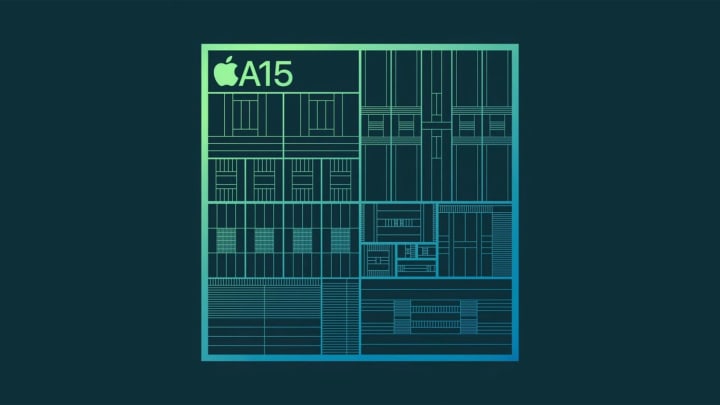
The renewal of the heart of the iPhone is presented in this generation as an important improvement especially in the graphics capabilities: It has one more GPU core than the A14 (going from 4 to 5 graphics cores) and has — as we have already commented — with a new video encoder and decoder that serves as a support for the main processor and that will give us more power even than what we can obtain as a reference in synthetic tests.
To measure the linear increase with respect to the previous generation, we will use Geekbench Pro 5, where we can numerically compare the increase in power. These have been the results:
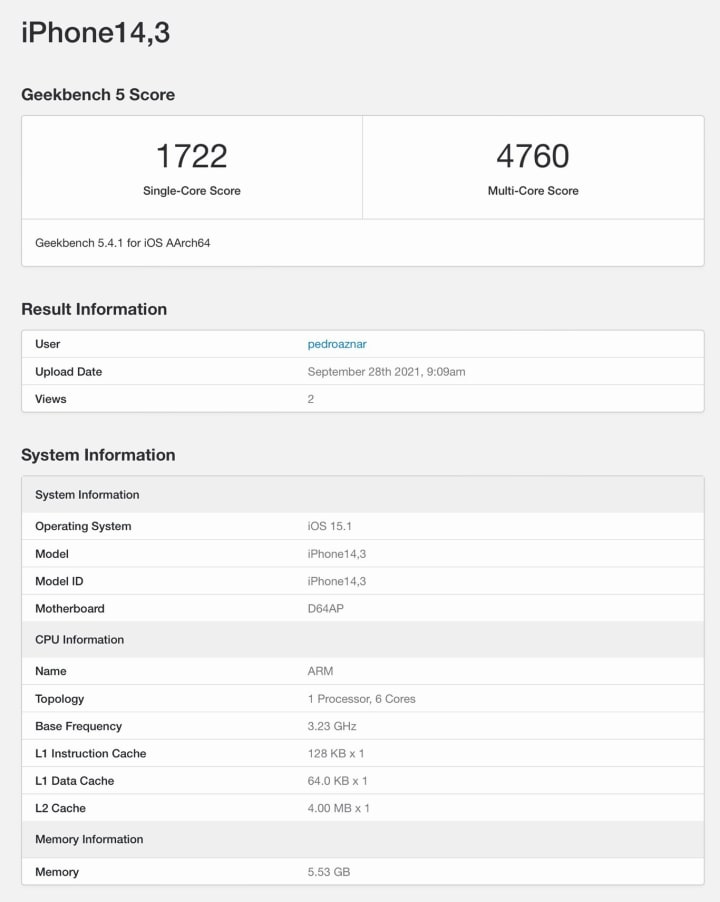
As you can see, we get 1722 as a single-core score and 4760 for multicore performance. Recalling the values we obtained last year with the iPhone 12 Pro Max (1591 and 4091), we obtain a linear improvement of between 10% and 15% in gross power. However, let’s remember the help of the decoder that speeds up rendering, export, and video editing processes, in addition to increasing the GPU to 5 cores. The improvement here is more than evident compared to previous generations:
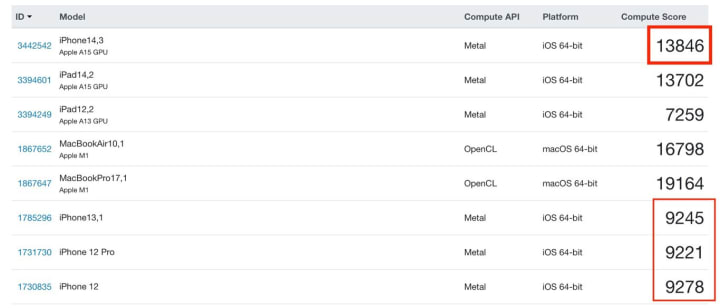
As you can see, the 13846 points place these iPhone 13 Pro around 33% faster than the iPhone 12 Pro, not so much for the raw power but for using one more GPU core. As all the synthetic values should only be taken into account to contextualize the generation, as I mentioned, the use on a day-to-day basis can be even better thanks to the new graphic encoders and the use of Machine Learning with the 16 cores of the Neura Engine dedicated to specific tasks.
The real leap is in the improvement of the battery of these models. Using the combination of efficiency and power cores in an intelligent way, and with a physical redesign of the battery of each model (now it is bigger) the improvement in the day-to-day is more than evident. The iPhone 13 Pro manages to reach the end of the day with an approximate 23% charge, after having used it with apps such as Outlook, Teams, Slack, Safari, Apple Music, Apple Maps, OneNote, and some sporadic video viewing on YouTube.
In the iPhone 13 Pro Max, we managed to end the day with more than 34% charge, using it intensively throughout the day and adding the capture of photographs and some video to the previous apps. Always with the brightness at 70% (outdoors at 100%). If we make less intensive use (I tried to force it by keeping the screen on between 7 and 8 hours), we can perfectly use it for two days in the way we usually use it.
The iPhone 13 Pro, more iPhone than ever
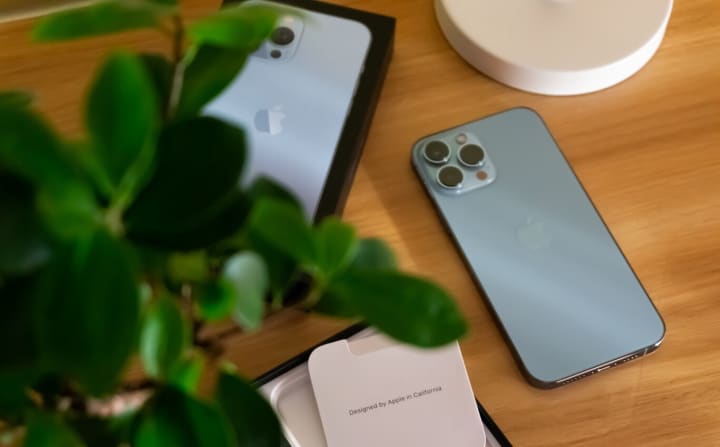
What seemed like a low-key update has materialized in underpinning each of the iPhone’s strengths. What makes an iPhone, an iPhone. Better screen, better battery, better cameras. Everything else was already around excellence, so those looking for the definitive iPhone — for the moment — here you have it: maintaining the prices of the previous generation, the iPhone 13 Pro range starts at $999 (+ $100 if we want a Pro Max).
One of the successes of this year has been the normalization in pairs: the iPhone 13 and iPhone 13 mini on the one hand, and the iPhone 13 Pro and iPhone 13 Pro Max on the other. In the latter case, both models are identical in every way, except on the screen and of course in autonomy — helping us to choose which is the best for us according to our type of use, but without leaving any “Pro” functionality out.
The very concept that Apple has been explaining to us since 2007 is more relevant than ever: Apple seeks to be relevant in what the iPhone does well, and tries to make it easy and accessible to the user. These Pro models serve both the audio or video professional and the user who simply seeks to improve their snapshots: a very good concentration of technology to get us to be creative, a powerful and increasingly mature tool. If there is a year to choose a Pro model, this generation deserves it, without a doubt.
Conclusion
The iPhone 13 Pro is a natural evolution of the iPhone 12 Pro. It doesn’t show monumental changes from last year’s devices, but it is a major improvement in many respects.
As a work tool for content creators, it seems fundamental and irreplaceable. If you create content for a living, go ahead, go for it. There is no other device on the market, in my opinion, that can do everything that Apple’s new smartphone can do.
It is good news that there is no difference in the camera system between the iPhone 13 Pro and 13 Pro Max since many people prefer smaller devices and that no longer means sacrificing performance.
It’s hard to beat the iPhone 12 Pro, I both considered them the best smartphones Apple has made, especially the Pro Max which already had a huge camera and an everlasting battery. The iPhone 13 Pro was built on those foundations and it does everything even better.
As a work tool, I can’t imagine anything better. Apple maintains its crown as king of the technological empire, building the best smartphones available in the market.
About the Creator
Juan Cienfuegos
Host of BitCorner 🎙️The 1st Salvadoran Bitcoin Podcast | Author of The Savior: #Bitcoin 🇸🇻⚡️ | engineer + educator
Enjoyed the story? Support the Creator.
Subscribe for free to receive all their stories in your feed. You could also pledge your support or give them a one-off tip, letting them know you appreciate their work.


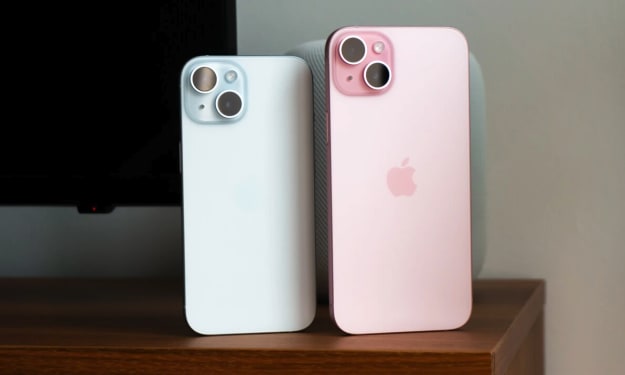



Comments
There are no comments for this story
Be the first to respond and start the conversation.